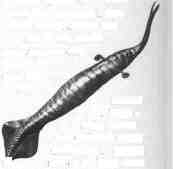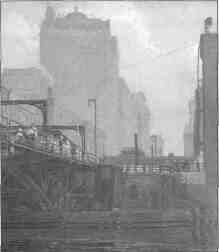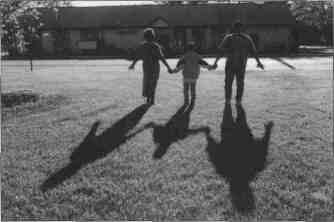BRIEFLY
Edited by Donald Sevener
ART FOR POLITICS' SAKE
Arts Council budget hits record,
thanks to politicians' pet projects
On the surface, the Illinois Arts Council's budget soared to record heights
this year. In reality, the agency says, the majority of that boost — about $6.4 million — went to politicians' pet projects. In all, eight projects were
funded by the legislature, skirting the Arts Council's process of awarding
grants through a competitive, peer review procedure. And though the funding
procedure was not unusual, the amount of money funneled by lawmakers to
projects through the Arts Council is the highest ever, according to council
officials. Moreover, some projects were not even related to the arts.
For example, the Illinois Humanities
Council, a not-for-profit organization
that develops programs and grants to
support public understanding of the
humanities, received $345,900. That money, says the council's executive director
Kristina Valaitis, will go toward several
programs, including a living history theater program, a traveling speaker's bureau
and summer seminars for K-12 teachers.
|

|
The Robert Crown Health and Science
Center in Hinsdale received $200,000 for
general operating purposes, says the center's president John Zaremba. The center,
a not-for-profit organization, is a health
education facility for school groups.
The remaining millions went to six
other projects, all but one in Chicago and
all arts-related.
"That $6.375 million equals our total
grant budget, which serves 1,100 arts
organizations and artists statewide," says
Kassie Davis, the Illinois Arts Council's
executive director. "Our grants are determined by expert peer review panels. When
organizations are given grants through
line items, they don't apply and nothing is
evaluated or reviewed."
So, Davis says, to get a true sense of
the arts council's budget, look at the base
figure. At $7.2 million, it's up $3 million
this fiscal year, but still about $2.7 million
shy of what it was in fiscal
year 1991.
|
"Every state agency took
a hit in the early '90s when
we were dealing with the
recession and the state's
deficit, but most agencies
have gone back up. The arts
council hasn't," says Davis.
Last fiscal year, Illinois
spent 63 cents per person on
the arts compared to the
national average of $ 1.02.
Jennifer Davis
Tully gets its due
|

|
The Tully Monster, a soft-
bodied marine animal that
lived 280 to 340 million
years ago, was designated the
state fossil
in 1989.Francis J. Tully, a Joliet farmer
who collected fossils,
discovered an impression of the Tully Monster in 1955. Since then, more
than 100 specimens of the as-yet-unidentified animal, between two
and 12 inches in length, have been
found in Grundy, Kankakee, Will
and Fulton counties. Mazon
Creek, which winds through
Grundy and Fulton counties, is
a rich storehouse of fossils,
including the Tully Monster. Now
Northeastern Illinois University
in Chicago, which manages the
protected fossil preserve area, has
published Richardson's Guide to
the Fossil Fauna of Mazon Creek,
the first comprehensive account
of the variety of fossils found
there. Edited by Northeastern
professor Charles Shabica and
associate project curator Andrew
A. Hay, the guidebook features
experts on the various aspects of
fossil life. Shabica initiated the
Mazon Creek Project in 1983 to
continue the work of Eugene S.
Richardson, a former curator of
paleontology at Chicago's Field
Museum. Richardson, who identified many of the fossils found at
the site, envisioned a book that
would share the vast findings
from the ancient coastal delta.
|
Beverley Scobell
8/ December 1997 Illinois Issues
ART HISTORY
Collector seeks to fill gap with book on 19th century Illinois artists
Ernest Martin Hennings wasn't
born here and didn't die here, yet
this 19th century painter has a place
in Illinois' art history. That place
will soon be detailed in A History of
Illinois Painters, 1850-1950, an
upcoming reference book featuring
more than 1,200 Illinois artists from
that period.
|

Chicago at the River by Ernest Martin Hennings
(1886-1956)
|
Joel Dryer, an art lover and
collector, has devoted the past four
years to researching Illinois artists
born before 1900. He's tracked
down surviving family members,
unearthed scrapbooks and scoured
public records. "I've run through all
the material out there," says Dryer,
whose quest began when he started
collecting paintings by Illinois
artists done between 1880 and 1930.
"I noticed there wasn't a whole lot
of information available on the
artists themselves."
Hennings, for one. Several
biographical dictionaries list
Hennings, but few give details about
his life. For example, it was Chicago art patron and then-Mayor Carter Harrison who convinced
Hennings to go to Taos, N.M.
Hennings is known for his
Western and Indian-inspired art.
Lauren Lessing, a reference
librarian at the Ryerson and
Burnham libraries at The Art
Institute of Chicago, notes there
are reference works available
now.
Esther Sparks' A Biographical
Dictionary of Painters and
Sculptors in Illinois, 1808-1945
was published in 1971. Artists of
Illinois, published two years ago,
indexes contemporary artists.
|
A catalog of other reference
sources is available through the
Art Institute's web page at
http://www.artic.edu.
Dryer can also be reached on
the Internet at http://www.enter-act.com/~illart/.
Jennifer Davis
Women writers
mark 25 years
Two and a half decades ago,
encouraging women's literary
expression seemed like a radical
idea, even to the writers themselves,
So say the members of Brainchild
Writers of Springfield in their new
collection of prose and poetry. But
Brainchild is now 25 years old. And
Springfield's longest running writers
group marked the event by publishingAll the Women Were Heroes,
an anthology of writing by the
group's past and current members.
Among the contributors are
University of Illinois at Springfield
faculty Jacqueline Jackson and
Maria Mootry, UIS staff members
Tavia Ervin and Marty McGill,
Illinois Issues editorial assistant
Debi Edmund, former associate
editor Peg Knoepfle and
contributor Sandra Olivetti Martin.
The anthology was funded in part
by a grant from the Springfield Area
Arts Council, the Illinois Arts
Council and First National Bank.
It was published by Rosehill Press in Springfield.
The Editors
Illinois Issues December 1997 /9
BRIEFLY
From the dust
Sculpture to rise from bricks of demolished housing
Representing both a tribute to the
past and a gesture toward the future, a
sundial sculpture will be created from
bricks retrieved from the demolition
of Springfield's John Hay Homes public
housing (see Illinois Issues, November,
page 20). Withrow School children, who
are enrolled in the Safe Haven after-
school program, will create the sculpture
with direction provided by Safe Haven
Director Irma Lott and Judy Spencer, a
free-lance photographer for Illinois
Issues and one of Safe Haven's volunteer art coordinators. A well-known Springfield sculptor, Fred Schaper, is an
adviser to the project.
|

Children of the Sun: A student and staff at Safe Haven depict
a sundial.
The finished project will include sculpted figures.
|
"The sundial will be a tribute to the
families that lived and thrived at the Hay
Homes," Spencer says. "It is an elaboration of the good things the Homes
offered to the community."
And there were good times. When the
Hay Homes housing project was created
in Springfield in 1939, it was one of the
first public housing projects built in
Illinois. Spencer says you can ask any
former resident about the early days; they have many good stories to relay.
It was not until the 1970s that the
atmosphere of public housing began to
change. By razing the structures, the
hope is that a community — not just
housing — will rise from the dust. "Let
this sculpture be a springboard for all
the good things to come," Spencer says.
The sculpture design, developed by
schoolchildren, depicts a man, a woman
and a child holding hands. Spencer
photographed models in various poses
representing that idea. After reviewing
the final design, Schaper suggested
making the sculpture a sundial.
|
The Hay Homes' bricks (with asbestosremoved) will be ground to a powder
and mixed with the concrete used in the
sculpture. Pending school district
approval, the sculpture will be located
at Withrow Early Childhood Center
located on the city's East Side.
Spencer says the sculpture is based
on the approach to art followed by Mose
Tolliver, Jimmy Lee Sudduth and
Thornton Dial, all self-taught African-
American folk artists and sculptors who
use already existing materials to create
art "from the soul."
Coordinators say the work will begin
in the spring when the weather is more
pleasant for outdoor work and daylight
hours are longer.
Linda Classen Anderson
|
WEB SITE OF THE MONTH
Visit a famous
gallery, exhibit
your own etchings
Do you have a desire to exhibit your artwork in a real gallery?
Want to chat with other artists?
Care to visit the Louvre but you
don't have enough frequent flyer
miles?
Head for the web, where a
wide world of art and artistic
opportunities awaits.
Those surfing the WWW for
art or artists would be wise to
start at The Art Stand, located
at http://www.aloha.net/~johnp/ylpg.html. The site is
comprehensive and fun. It contains a directory of artists,
resources for art teachers and
students, art lessons and crafts,
online tutorials, interactive art
and a page where Kids Rule!
The Interactive Art page is
worth a visit itself because it
contains such links as "Ask the
Artist"; an art chat; a Real-time
Gallery where you can browse,
upload and critique works of
art; classified ads; and a Paint
online page that invites you to
"Java paint your masterpiece." It
provides the tools, and promises
to display the best art in its
online gallery.
The Kids Rule page offers
links to art activities, the
performing arts, dance, young
artists, music, cartoons, sculpture, books, painting and stories.
In the activities section, kids can
visit Dodo Land in Cyberspace,
the Electric Origami Shop,
which promises "neat images
and shapes from IBM technology," a Global Show-n-Tell
Museum containing works by
kids from toddlers to teens. And
they can get a holography lesson
and learn How to Cloud Watch.
It's a blast for kids (and fun for
adults as well).
Donald Sevener
|
10/ December 1997 Illinois Issues
FALL SESSION CHECKLIST
Lawmakers deregulate electric utilities,tighten rules on state contracts and hog farms
Illinois' nine investor-owned power
companies will be forced into a fully
competitive marketplace in the next
decade under legislation sent to the
governor's desk. Utility deregulation
will be phased in beginning next year if
Gov. Jim Edgar signs the plan.
Under the agreement, residential
customers of Chicago-based Common-
wealth Edison and Illinois Power Co. of
Decatur should see their prices go down
next winter. Residential rates would
drop 15 percent August 1 and another 5
percent in 2002. ComEd and IP, the
state's two largest utilities, charge the
highest residential prices. In 1995,
ComEd's cost per kilowatt hour was
11.39 cents. IP's was 10.10 cents. The
Midwest average was 7.77. (See Illinois
Issues, October, page 24.)
Peoria-based Central Illinois Light
Co. will phase in a 5 percent residential
rate cut over three years. At 7.10 cents
per kilowatt hour, CILCO's residential
customers already pay below the Midwest average. Other investor-owned
utilities will drop their residential rates
5 percent next year. Residential
customers of investor-owned utilities
could begin shopping for power in
2002. Industrial and large business customers could begin shopping as early as
1999. However, all customers would
have to pay a "transition fee" for the
privilege of switching. Under the plan,
those fees will be eliminated in 2006.
State agencies and universities face
more extensive purchasing oversight
under ethics reforms sent to Edgar. If
the governor agrees, most contracts,
and changes in contracts, will be open
to competition. Exceptions will include
supplies that cost less than $10,000,
construction projects that run less than
$30,000, sole source items and emergency purchases. The measure creates
a five-member board to review and
recommend procurement rules for the
Department of Transportation,
Central Management Services, the
Capital Development Board and all
state universities.
Rep. Jeffrey Schoenberg, an
Evanston Democrat who has pushed for
the changes for years, called the vote
"nothing short of the Cubs winning the
pennant, I tell you."
Hog farm opponents gained some
ground. Lawmakers sent the governor a
measure requiring the Department of
Agriculture to conduct regular inspections of the larger operations. It also
requires reporting of waste spills within
24 hours of discovery, and notification
of county boards when operations plan
to build or modify an earthen waste
lagoon.
Lawmakers also:
• banned most "partial birth"
abortions after agreeing to Edgar's
change eliminating a provision allowing
biological fathers to sue;
• established a maximum $500
tax credit for families that send their
children to nonpublic schools;
• boosted their own office allowances
by $10,000.
Jennifer Davis
Illinois Issues December 1997 /11



